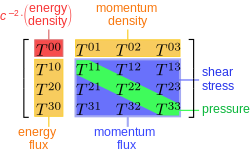In physics, a perfect fluid or ideal fluid is a fluid that can be completely characterized by its rest frame mass density and isotropic pressure . Usually, "perfect fluid" is reserved for relativistic models and "ideal fluid" for classical inviscid flow.[citation needed] Real fluids are "sticky" and contain (and conduct) heat. Perfect fluids are idealized models in which these possibilities are ignored. Specifically, perfect fluids have no shear stresses, viscosity, or heat conduction. A quark–gluon plasma [1] and graphene are examples of nearly perfect fluids that could been studied in a laboratory.[2]
D'Alembert paradox
[edit]In classical mechanics, ideal fluids are described by Euler equations. Ideal fluids produce no drag according to d'Alembert's paradox.
Relativistic formulation
[edit]
In space-positive metric signature tensor notation, the stress–energy tensor of a perfect fluid can be written in the form
where U is the 4-velocity vector field of the fluid and where is the metric tensor of Minkowski spacetime.
In time-positive metric signature tensor notation, the stress–energy tensor of a perfect fluid can be written in the form
where is the 4-velocity of the fluid and where is the metric tensor of Minkowski spacetime.
This takes on a particularly simple form in the rest frame
where is the energy density and is the pressure of the fluid.
Perfect fluids admit a Lagrangian formulation, which allows the techniques used in field theory, in particular, quantization, to be applied to fluids.
Perfect fluids are used in general relativity to model idealized distributions of matter, such as the interior of a star or an isotropic universe. In the latter case, the equation of state of the perfect fluid may be used in Friedmann–Lemaître–Robertson–Walker equations to describe the evolution of the universe.
In general relativity, the expression for the stress–energy tensor of a perfect fluid is written as
where is the 4-velocity vector field of the fluid and where is the inverse metric, written with a space-positive signature.
See also
[edit]References
[edit]- ^ WA Zajc (2008). "The fluid nature of quark–gluon plasma". Nuclear Physics A. 805 (1–4): 283c – 294c. arXiv:0802.3552. Bibcode:2008NuPhA.805..283Z. doi:10.1016/j.nuclphysa.2008.02.285. S2CID 119273920.
- ^ Müller, Markus (2009). "Graphene: A Nearly Perfect Fluid". Physical Review Letters. 103 (2). doi:10.1103/PhysRevLett.103.025301.
Further reading
[edit]- S.W. Hawking; G.F.R. Ellis (1973), The Large Scale Structure of Space-Time, Cambridge University Press ISBN 0-521-20016-4, ISBN 0-521-09906-4 (pbk.)
- Jackiw, R; Nair, V P; Pi, S-Y; Polychronakos, A P (2004-10-22). "Perfect fluid theory and its extensions". Journal of Physics A: Mathematical and General. 37 (42): R327 – R432. doi:10.1088/0305-4470/37/42/R01. ISSN 0305-4470. Topical review.







![{\displaystyle \left[{\begin{matrix}\rho _{e}&0&0&0\\0&p&0&0\\0&0&p&0\\0&0&0&p\end{matrix}}\right]}](https://wikimedia.org/api/rest_v1/media/math/render/svg/875c5a58c98b9d041855127d579206c801800fe0)


